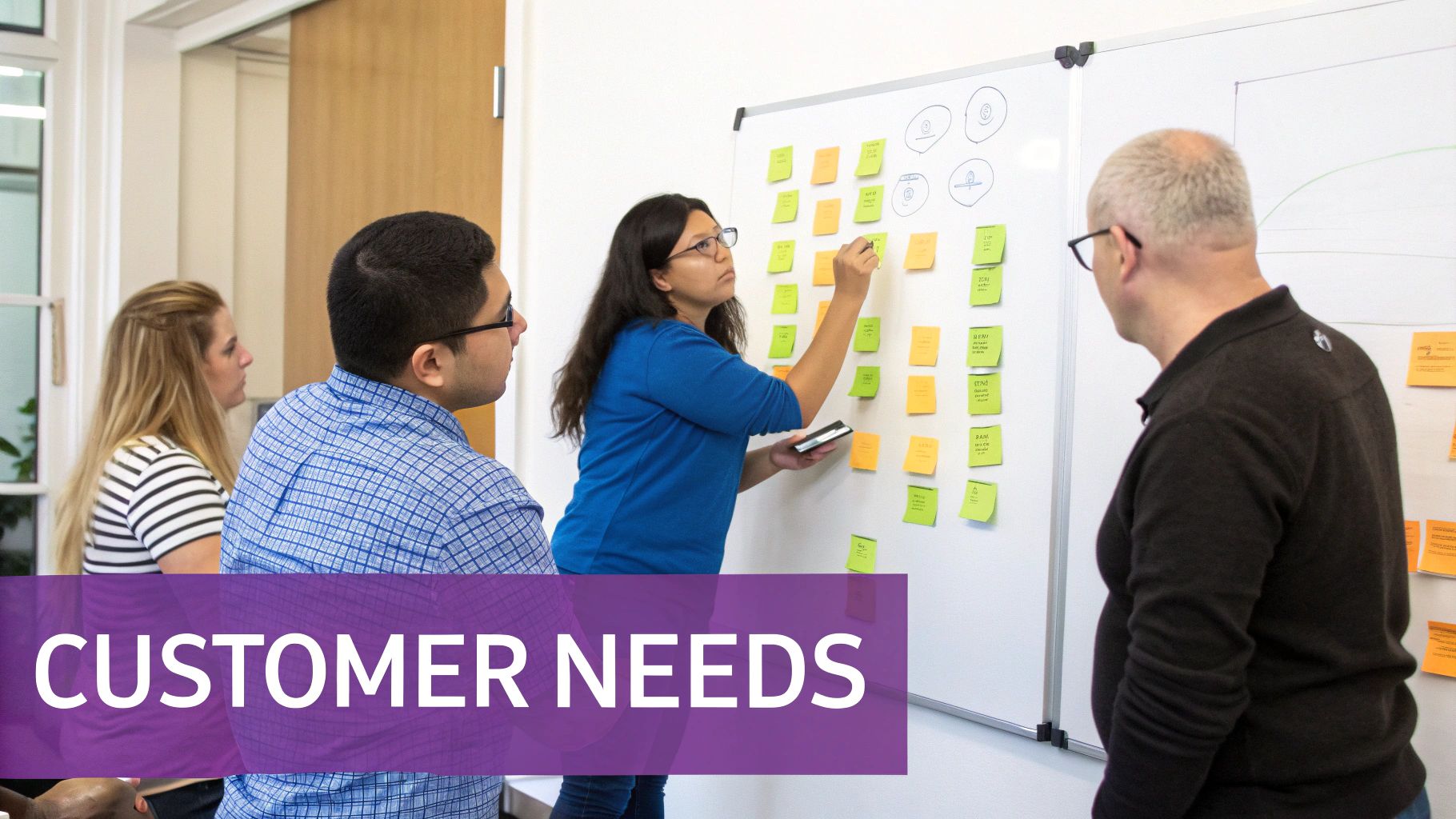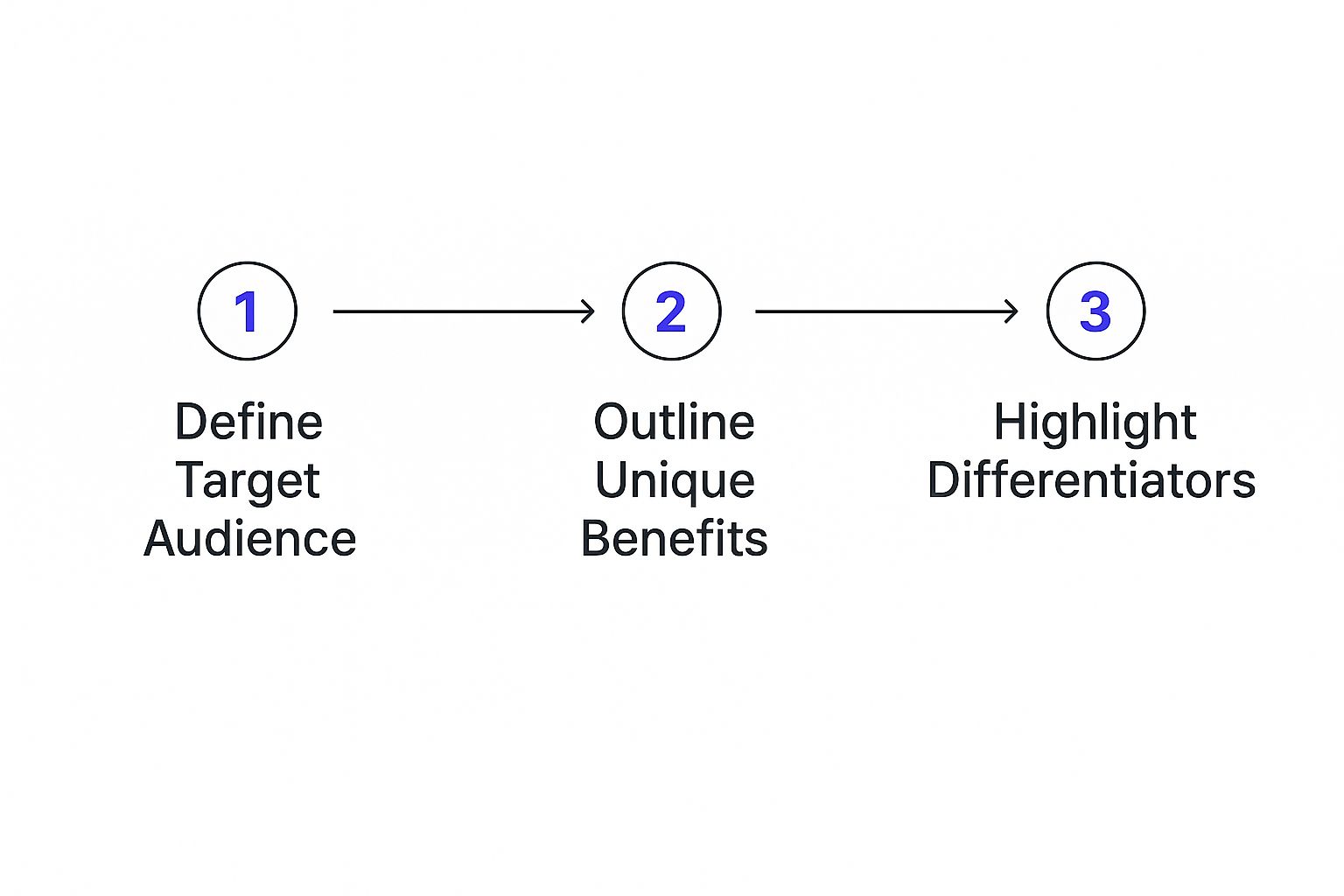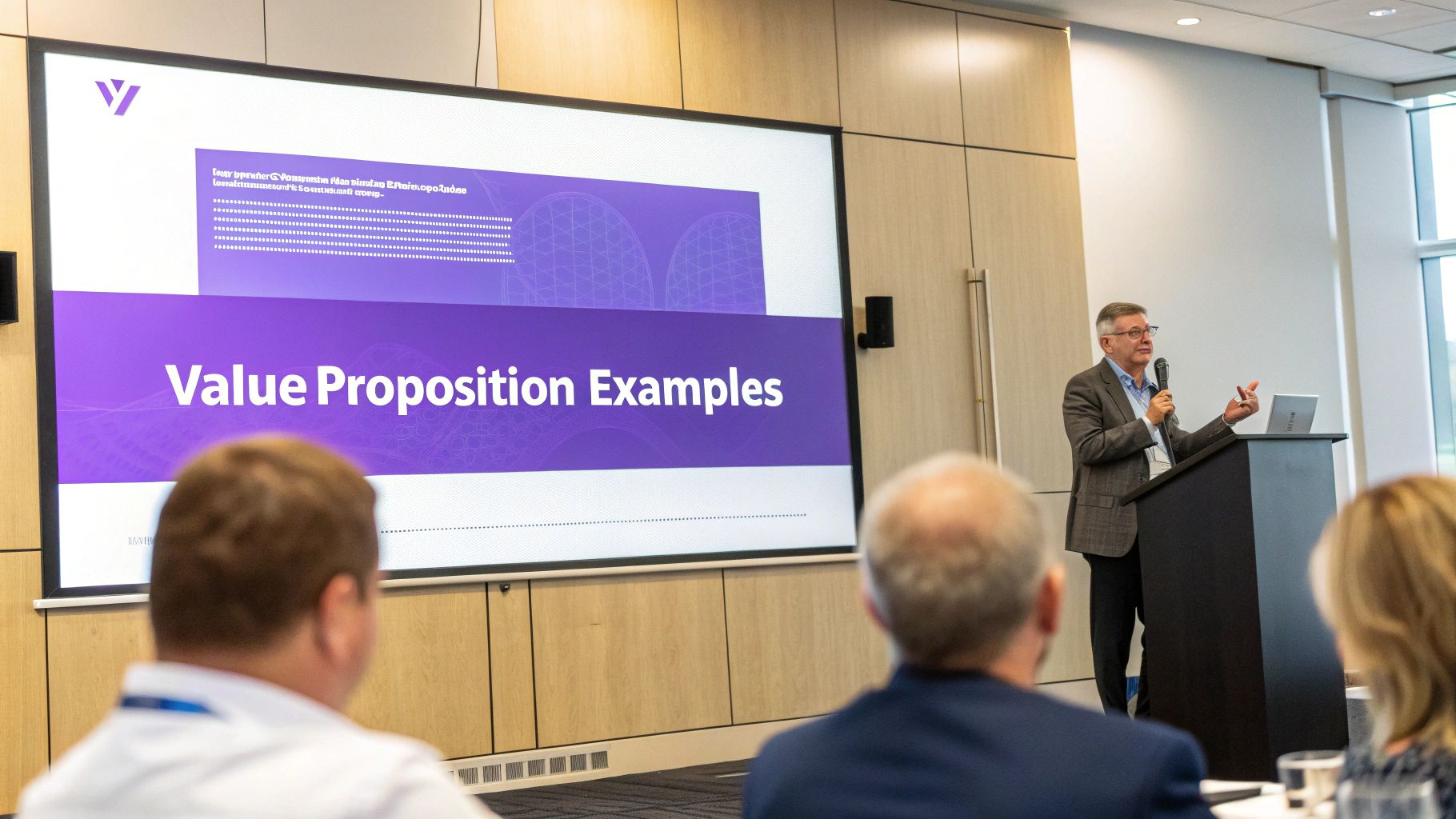How to Create a Value Proposition That Captivates

To craft a value proposition that really connects, you first need to see it for what it is: a clear, direct promise of the tangible results someone gets from working with you. It’s the simple, compelling answer to a potential client's core question: "Why should I pick you over everyone else?"
What a Value Proposition Actually Is and Why It Matters
Before we dive into building one, let's get on the same page about its role. A value proposition isn't just a clever tagline or a bit of marketing fluff. It’s the strategic heart of your brand, the core promise that carves out your space in a noisy marketplace.
Think of it as the sum of two parts: the value you promise to deliver and a customer's belief that you’ll actually make good on that promise.
A solid value proposition becomes the North Star for your entire business. It shapes how you develop your services, gets your sales and marketing teams rowing in the same direction, and lays the foundation for real, sustainable growth. Without it, your messaging feels disjointed, and potential customers are left scratching their heads, wondering what makes you special.
The Strategic Role in Business
A well-defined value proposition does more than just win over clients. The process of creating one forces you to get brutally honest about who you serve, what deep-seated problems you solve, and what makes your solution genuinely different. That kind of clarity is a massive business advantage.
For a deeper dive into the mechanics, this guide on what a value proposition is and how to create an effective one is an excellent resource.
At its core, a strong value prop performs three key jobs:
- Differentiation: It spells out exactly how you stand apart from the competition.
- Relevance: It draws a straight line from your offerings to your customer's biggest pain points.
- Clarity: It delivers this message in simple terms anyone can grasp in seconds.
Ultimately, a great value proposition greases the wheels of decision-making for your ideal customer. It instantly signals that they've come to the right place.
A value proposition is the bridge between what your service does and what your customer needs. It’s the mantra that ensures everything you build and say delivers real-world, tangible value.
Beyond a Simple Slogan
It's easy to mix up a value proposition with a catchy slogan. A tagline like Nike's "Just Do It" is a memorable marketing snippet. A value proposition is the substance behind it. It’s the nitty-gritty explanation of the benefits, costs, and overall value a customer can expect.
For example, a speaker using our platform, SpeakerFlow, doesn't just get a QR code. Their value proposition is the ability to turn audience engagement into measurable sales pipeline—without ever derailing their presentation. This distinction is everything when it comes to creating messaging that actually gets people to act.
A truly effective value proposition has a few key ingredients that work together. Here's a breakdown of what makes one tick.
The Anatomy of a Powerful Value Proposition
A powerful value proposition is made up of a few key components that work together to communicate your value quickly and effectively.
- Headline: This is the big promise. It's a single, attention-grabbing sentence that summarizes the primary benefit. The key question it answers is: What is the #1 result you deliver to your customer?
- Sub-headline: This is a 2-3 sentence paragraph that explains what you do, who it's for, and why it's useful. It answers the question: How do you deliver on the headline's promise?
- Bullet Points: These are 3-5 key features or benefits that add credibility and detail to your promise. They answer the question: What specific features or outcomes make your offer compelling?
- Visual Element: An image, hero shot, or short video that shows your product or service in action. This element should answer the question: How can you visually reinforce your core message?
Each of these elements plays a critical role in making it easy for your ideal customer to say, "Yes, this is for me."
Discovering What Your Customers Truly Want

The best value propositions don't come from a flash of genius in a team meeting. They're discovered by listening—really listening—to the people you want to serve. Forget just scratching the surface with job titles and company sizes. The real gold is in understanding your audience's psychographics: their motivations, their biggest headaches, and what they're truly trying to achieve.
Before you can nail down what your audience wants, you have to get out there and gather some intel. Exploring the essential market research types is your first move. This isn't about throwing darts at a board; it's about building a foundation of solid evidence.
When you do this right, your message stops being about what you do and starts connecting with the real-world problems your audience is desperate to solve.
Moving From Data To Empathy
Generic customer profiles get you nowhere fast. They lead to bland, forgettable messaging. To create a value proposition that actually lands, you need to know more than just who your customer is. You have to understand what it’s like to walk in their shoes. What’s keeping them up at night? What does a huge win feel like for them?
This means getting your hands dirty with a mix of research methods designed to pull out raw, unfiltered insights. You’re looking for their actual pains and desired gains.
Here are a few ways to get started:
- Customer Interviews: Seriously, just talk to people. Have candid chats with your best clients and even some prospects. Ask open-ended questions about their day-to-day challenges and what solutions they’ve already tried.
- Social Listening: Go hang out where your audience lives online—LinkedIn groups, forums, even Twitter threads. Pay close attention to the exact words and phrases they use to describe their problems. It’s a goldmine.
- Survey Analysis: Send out smart, targeted surveys to validate what you think you know. Focus on their desired outcomes, not just a checklist of features they might want.
The patterns that emerge from this work are the building blocks for a message that truly speaks to your audience.
Synthesizing Your Research Into Personas
Once you've got all this great intel, it's time to pull it together into customer personas. I'm not talking about those flimsy, one-page summaries of demographic data. I mean rich, story-driven profiles that feel like real people.
A persona isn't just a description of your buyer. It's a story about their goals, the obstacles in their way, and the transformation they are seeking. This story is the foundation of your value proposition.
For example, your persona for a Field Marketing Manager might zero in on her constant pressure to prove event ROI and her frustration with leads that vanish after a great presentation. That specific, detailed pain point is exactly what you can build your message around. If you need a framework, our guide on https://speakerstacks.com/resources/how-to-create-buyer-personas walks you through creating these step-by-step.
By turning raw data into relatable human stories, you set yourself up to write a value proposition that doesn't just state a fact—it shows deep, genuine understanding. That empathy is what makes a message stick.
Finding Your Unique Edge in a Crowded Market

Once you know exactly who you're talking to, it's time to get brutally honest about what makes you the only logical choice. To really cut through the noise, you have to pinpoint your specific advantage. It's a lot like an artist finding your unique angle in a gallery full of paintings. This isn’t about boasting more features; it’s about having the right features that deliver a benefit no one else can touch.
Your mission is to find that one thing you do better than anyone else for your ideal audience. This is your unique selling proposition (USP). It’s that sweet spot where what you do best perfectly aligns with a customer need that your competitors are either ignoring or just not handling well.
Mapping Your Strengths to Customer Outcomes
First, let's map out everything your service actually delivers. Don't just make a list of features. For every single feature, you have to ask, "So what?" and answer it from your customer's perspective.
Take a SpeakerStacks user, for example. They don't just get a QR code. They get a seamless way to capture leads while they're still on stage. What that really means is they can finally prove the ROI of their speaking gigs. The QR code is just the tool; the proven ROI is the game-changing outcome.
Here’s a simple way to think about it:
- Tangible Benefits: These are the results you can measure. Think more leads, better conversion rates, or hours saved.
- Intangible Outcomes: These are the emotional wins. This could be feeling more confident on stage, eliminating that post-event stress, or simply looking like a pro who has their act together.
The biggest mistake I see speakers make is leading with features. Nobody buys features. They buy the transformation those features enable. Your value proposition has to scream that transformation.
Sizing Up the Competition
Next, you need to know who you're up against. Take a hard look at your top three to five competitors and really dissect how they talk about themselves. Don't just skim their homepages—dig into their customer reviews, their ads, and their case studies.
Get answers to these questions:
- What's the main benefit they're promising?
- Who are they really talking to?
- What words and phrases do they keep using?
- Are there common complaints or things customers wish they did better?
This little bit of detective work is where you'll find the gold. You might discover your competitors are all chasing enterprise clients, leaving a massive opening for you to become the go-to for solo consultants. Or maybe they all sound the same, obsessing over technical features, which gives you the perfect opportunity to build your brand around emotional benefits like confidence and peace of mind.
This isn't just theory. When companies fine-tune their messaging for different customer groups, they often see relevance and conversions jump by 20-30%. Why? Because the message feels like it was written just for them. It’s how you craft a value proposition that doesn't just attract your ideal customer—it makes them feel understood.
Turning Your Insights Into a Statement That Clicks
Alright, you've done the hard work. You know your audience inside and out, and you have a solid grasp of what makes your approach special. Now comes the moment of truth: boiling all that research down into a sharp, compelling value proposition.
This isn't just about stringing words together. The goal is to craft a message so clear and resonant that your ideal customer "gets it" in seconds and feels an undeniable pull to learn more. We're moving from strategy to a statement that does the heavy lifting for you.
To get there, we'll lean on a few proven frameworks. Think of these less as rigid templates and more as battle-tested structures that tap into the core motivations of a buyer. They help you organize your thoughts and ensure you hit all the right notes.
This simple diagram shows how the pieces fit together—you start with the audience, connect to their desired benefits, and then seal the deal with what makes you different.

As you can see, it's a sequence. You can't really talk about your unique benefits until you're crystal clear on who they're for.
Using Formulas for Clarity, Not as a Crutch
Formulas get a bad rap sometimes, but they can be incredibly helpful for forcing clarity. They make you distill your message down to its absolute essence. One of the most effective I've come across is from Steve Blank, a giant in the Lean Startup world.
His structure is beautifully simple: "We help (X) do (Y) by doing (Z)."
- X = Your Target Customer. Get specific here. "Field marketing managers" is much stronger than just "marketers."
- Y = The Job They Need Done. What's the transformation they're really after?
- Z = Your Secret Sauce. This is how you deliver that incredible outcome.
Let's see it in action for SpeakerStacks:
"We help (X) sales leaders and marketers to (Y) prove the ROI of their speaking events by (Z) turning audience engagement into CRM-tracked pipeline."
This works because it’s dense with value. A sales leader immediately understands that this solves one of their biggest headaches: justifying the budget for speaking gigs by connecting them directly to revenue.
The Geoff Moore Deep-Dive for Competitive Positioning
If you need a more robust structure, especially when you're up against established competitors, Geoff Moore’s classic formula from Crossing the Chasm is pure gold.
Here’s the framework: "For (target customer) who (statement of need or opportunity), our (product/service name) is a (product category) that (statement of key benefit). Unlike (primary competitive alternative), our product (statement of primary differentiation)."
Let's imagine a consultant who uses our platform. Here's how they might use it:
- For business coaches who present at industry workshops…
- who struggle to turn those one-off attendees into paying clients…
- SpeakerStacks is a lead-capture tool…
- that builds a seamless bridge from your presentation to your sales pipeline.
- Unlike just dropping your email address or using a generic contact form…
- our product gives you a branded, trackable microsite that captures qualified leads and syncs them right into your CRM, finally proving your event's value.
A great value proposition doesn't just explain what you do. It demonstrates such a deep understanding of your customer’s world that your solution feels like the only logical choice.
What I love about this more detailed format is how it forces you to name your differentiator head-on. In a noisy market, that's everything. It also gives you the raw material for building powerful social proof.
Once you have a statement like this, you can start gathering stories that back it up. In fact, these value statements are the perfect foundation for compelling narratives. You can learn more about how to do that by checking out our guide on how to create case studies that validate your claims.
No matter which framework you use as a starting point, always remember to speak your customer's language. Ditch the internal jargon and focus on the results they actually dream about. The final statement should be simple, direct, and all about their success.
Testing and Refining Your Message with Real-World Data
So, you’ve crafted what feels like the perfect value proposition. That's a great first step, but right now, it's just a well-educated guess. The real magic happens when your message makes contact with your audience. Think of your value proposition not as a finished product, but as a living statement that needs to breathe, adapt, and evolve with real feedback.
This is the point where you stop guessing and start knowing. You're about to let your audience's actions—their clicks, their time, their sign-ups—tell you what actually works. It’s time to move from assumption to evidence.
Setting Up Your First Tests
Testing doesn't have to be a massive, expensive production. The goal is simple: get your message in front of your ideal audience and see how they react. A small, focused social media ad campaign is a perfect place to start.
For example, you could run two or three different ad versions, each highlighting a distinct angle of your value proposition.
- Version A: Focuses on a concrete outcome. Think: "Finally Prove Your Event's ROI."
- Version B: Taps into an emotional benefit. Maybe: "Speak with Unshakeable Confidence."
- Version C: Leans on your unique differentiator. Something like: "Capture Leads Without Derailing Your Talk."
With a small budget, you can quickly gather data on which message earns the most clicks or generates the most interest. This isn't just theory; it's direct, quantifiable feedback from the very people you want to reach.
Another fantastic method is A/B testing on your landing page. Simple tools let you show 50% of your visitors one headline and the other 50% a different one. The version that gets more people to sign up, download, or buy is your clear winner. It's a straightforward way to let your audience vote for the most compelling promise.
Identifying the Metrics That Matter
To figure out if your tests are successful, you have to track the right numbers. Vague metrics are useless here. You need to zero in on key performance indicators (KPIs) that directly show how well your value proposition is connecting.
Watching your conversion rate, acquisition cost, and engagement metrics is how you measure the true impact of your message. Tools like Google Analytics or your CRM system are your best friends in this process, providing the hard data you need for ongoing refinement. According to insights on Zigpoll.com, this data-driven approach is fundamental for articulating a message that truly stands out.
Here are the key metrics I always keep an eye on:
- Conversion Rate: What percentage of people took the action you wanted? This is the ultimate verdict on your message's power.
- Bounce Rate: How many visitors landed on your page and left immediately? A high bounce rate often signals a disconnect between your ad's promise and your page's content.
- Time on Page: How long are people sticking around? More time spent suggests your message is hitting the mark and pulling them in.
The goal of testing isn't to find a single, 'perfect' value proposition that lasts forever. It's to find the strongest version for right now and create a system for continuous improvement fueled by real customer behavior.
These data points give you an objective, unbiased look at what's actually working. For a more comprehensive look at which numbers to track, our guide on mastering marketing performance metrics is a great resource. Following this process turns message refinement from a guessing game into a strategic, data-backed discipline.
Weaving Your Value Proposition Into Everything You Do

Here's a hard truth: a brilliant value proposition is useless if it only lives on your homepage or a single slide in your pitch deck. For it to really land and generate results, it needs to be the consistent, underlying heartbeat of your entire business. Think of this as the final, crucial step—moving your message from a concept on paper to a living, breathing part of every interaction a customer has with your brand.
This is all about building trust through consistency. When your marketing emails, sales calls, and even your customer support chats all echo the same core value, your brand feels solid and dependable. It’s the difference between a brand that sticks in someone’s mind and one that just feels scattered and forgettable.
Getting Every Department on the Same Page
True integration happens when your value proposition evolves from a marketing asset into a company-wide philosophy. Every single team, from sales to product development, needs to see clearly how their work helps deliver on that core promise. When you achieve that kind of alignment, the customer journey feels seamless—from the first ad they see to the support ticket they file a year later.
So, how do you make this happen in the real world?
- Marketing Campaigns: Every blog post, social media update, and email you send should be a reflection of a key benefit from your value proposition.
- Sales Pitches: Your sales team should be armed with discovery questions that directly uncover the customer's pain points, allowing them to frame your solution as the perfect answer.
- Customer Service: Your support scripts and training shouldn't just be about closing tickets. They should empower your team to solve problems in a way that reinforces your brand’s unique value, whether that's unmatched expertise, lightning-fast responses, or genuine empathy.
A value proposition isn't just a marketing slogan; it's the promise you consistently deliver to your customers. When what you say and what you do are in perfect sync, your brand becomes a force to be reckoned with.
Tapping Into Modern Consumer Values
Today, a powerful value proposition often needs to speak to more than just product features and benefits. It has to connect with the ethical and social values of your audience. Consumers are actively choosing to spend their money with brands that mirror their own principles. For instance, an IBM study found that nearly 60% of consumers globally are willing to change their buying habits to reduce environmental impact.
Weaving values like sustainability or ethical sourcing into your message isn't just about corporate responsibility; it's a potent differentiator. It tells your audience that you understand what truly matters to them. This approach elevates your value proposition from a simple business tool to a core piece of your brand's identity, forging a much deeper, more lasting connection with the people you want to serve. You can explore more on this topic by reading about aligning your value proposition with emerging consumer trends.
Ready to turn your speaking engagements into a powerful lead generation engine? SpeakerStacks gives you the tools to capture audience interest, prove your event ROI, and seamlessly connect your presentations to your sales pipeline. Discover how it works at https://speakerstacks.com.